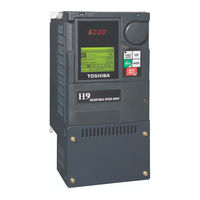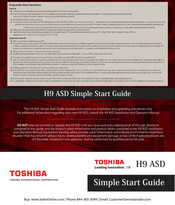Toshiba H9 ASD Network Card Manuals
Manuals and User Guides for Toshiba H9 ASD Network Card. We have 2 Toshiba H9 ASD Network Card manuals available for free PDF download: Installation And Operation Manual, Simple Start Manual
Toshiba H9 ASD Installation And Operation Manual (287 pages)
Adjustable Low Voltage Heavy Duty Industrial Speed Drive
Brand: Toshiba
|
Category: Network Card
|
Size: 3.64 MB
Table of Contents
-
-
-
EOI Features37
-
LCD Screen39
-
-
-
-
Type Reset86
-
Acceleration87
-
V/F Pattern88
-
Preset Speed90
-
Base Frequency 2105
-
Base Frequency 3106
-
Base Frequency 4107
-
Speed Control112
-
Frequency Mode 2115
-
Run Frequency130
-
End Frequency131
-
Jog Frequency133
-
Jog Stop Pattern134
-
Jump Frequency 2138
-
Preset Speeds138
-
Retry Selection142
-
Dynamic Braking143
-
Ridethrough Time144
-
Random Mode145
-
Drooping Gain146
-
Release Time150
-
Creeping Time151
-
Autotuning 1158
-
Autotuning 2159
-
RR Input Bias169
-
RR Input Gain169
-
RX Input Bias169
-
RX Input Gain169
-
Pattern 1 Repeat178
-
Pattern Group 1179
-
Pattern 2 Repeat181
-
Pattern Group 2182
-
Over-Torque Trip192
-
ASD Overload195
-
Display Bias204
-
Trace Selection207
-
Trace Cycle208
-
Trace Data208
-
ASD Number209
-
Figure 35-G212
-
Point 1 Setting212
-
Point 2 Setting212
-
Block Write Data218
-
Block Read Data219
-
Free Notes220
-
Traverse Step240
-
-
-
Alarms253
-
Trips/Faults255
-
-
Conduit Plate262
-
D E R1 R2262
-
Figure 34-A262
-
Figure 34-B262
-
-
Figure 31262
-
-
212K271
-
-
-
Index277
-
Advertisement
Advertisement

